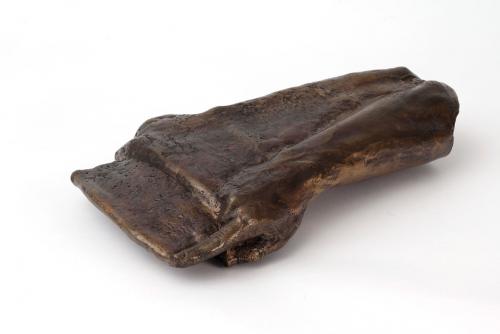Asaf Elkalei
Scopes
„Perception cannot be described as one of the many facts which exist in the world, since we are never able to supress that empty spot in the image of the world which is ourselves, at which point it begins existing for someone – because perception is the ‘mistake’ in this ‘great gem’.“[1]
The visibility of things is not a quality which „exists“ without being produced and formed in studios, laboratories, or institutions. In Asaf Elkalai’s work, the interest in photography lies in going beyond just the idea of „making an image“: the process involves the apparatus itself and extends to the viewer.
Repercussions of a kind of „mechanical image“ from a history of photography seem to run through the work – in a way, the story of this image-making process corresponds to the history of image-production itself, as it does to the story of „perceiving perception“ including the meandering status of visualisations and their functions, their aesthetics and affectivity in different times and places of knowledge formation, beyond the realm of art. In the work, the quality of the situation, the experiment, the laboratory tend to pop up or emerge in the form and shape of the object, such as the ethnological sujet of a geological stone and the desire to maximize information by representing it from multiple sides, paradoxically heightening the formal and mythical effect – wouldn’t it be nice to imagine that the camera, the automat and its interior mechanism had taken over to draw the image, taking into account its travels across mountains and the sea, it’s curiosity in peeking into indigenous darkrooms, going hiking and carefully processing the specific quality of the light in its foreign surroundings?
Sometimes, references to art appear to be closer, such as in the bronze scuplture of a gesture engaging in the seemingly mundane, but quite emotional chore of operating the touchscreen of a mobile phone – hand and eye are involved in a daytoday technique which, in its subtlety, weighted by the anachronistic medium, might be revealing concepts of motion, tactility and the visual in a similar way the stopmotion photographs of a horse’s gallop or the futuristic representation of a striding body might have attempted to deal with these issues in the late 19th or early 20th century.
The kaleidoscopic film sequences, often revealing glimpses of the human figure of the artist, seem to play with an idea of „world“ the camera’s particular perspective, a sitemosaic placed over the space of vision; but also, the world of the illusionistic space of a painting. Similarly, variations or echos of panorama or cyclorama refer to histories of spectacle and the story of early cinema; a window shutter alludes to the microcosm space of a stage. In this sense, „the real“ is revealed as something „under construction.”[2]
[1] Maurice Merleau-Ponty, Phänomenologie der Wahrnehmung. p. 244.
[2] Ilse Lafer, Behind the Fourth Wall, in: Ilse Lafer, Behind the Fourth Wall.
Fictitious Lives – Lived Fictions. p. 130.
Scopes
„Die Wahrnehmung ist nicht zu beschreiben als eines unter den Fakten, die in der Welt vorkommen, da wir im Bilde der Welt nie jene leere Stelle zu unterdrücken vermögen, die wir selbst sind, und in der sie erst dazu gelangt, für jemanden dazusein – da die Wahrnehmung der ‘Fehler’ in diesem ‘großen Edelstein’ ist.“ [1]
Die Sichtbarkeit von Dingen ist keine Qualität, die „exisitert“, ohne in Ateliers, Laboren oder Institutionen produziert und gestaltet zu werden. [2] Das Interesse an der Fotografie in Asaf Elkalai‘s Arbeiten geht über die Idee, „ein Bild zu machen“, hinaus: Dieser Prozess beinhaltet den Apparat und erstreckt sich bis zum Betrachter.
Rückwirkungen „mechanischer Bilder“ aus der Geschichte der Fotografie scheinen sich durch die künstlerischen Arbeiten zu ziehen – dabei läuft die Geschichte dieser besonderen Bildentstehungsprozesse neben einer Geschichte der Bildproduktion her (zugleich womöglich auch neben einer Geschichte des „Wahrnehmens der Wahrnehmung“), worin der mäandernde Status von Visualisierungen und ihre Funktionen, Ästhetiken und Affektivitäten zu unterschiedlichen Zeiten und Orten der Wissensformierung, über das Gebiet der Kunst hinaus, eingeschlossen sind.
Dabei tauchen Qualitäten der Situation, des Experiments oder des Labors in den künstlerischen Arbeiten auf und schlagen sich in ihrer Form nieder, beispielsweise im ethnologischen Sujets des geologischen Steins und seiner Darstellung; dabei führt der Wunsch, Informationen darüber zu maximieren, bis sich drei Ansichten davon überlappen, paradoxer Weise zu einer Steigerung des formalästhetischen und mythischen Effekts. Ließe sich vorstellen, dass die Kamera selbst, der Automat mit seinem mechanischen Innern, das Bild gezeichnet hätte, wobei man sich seine Reise über Berge und Gewässer vor Augen führt, Wanderungen und neugierige Blicke in einheimische Dunkelkammern, oder ihr sorgfältiges Prozessieren des ortsspezifischen Lichts in einer fremden Umwelt?
Manchmal scheinen die Referenzen zur Kunst näher an den Arbeiten zu sein. So zum Beispiel in einer Bronzeskulptur, in der Gesten einer zunächst banalen, aber sehr emotionalen Arbeit des Operierens und Bedienens des Touchscreens eines Mobiltelefons eingefroren sind – Hand und Auge sind in einer Alltagstechnik involviert, die, trotz ihrer scheinbaren Subtilität, überfrachtet durch das anachronistische Medi-
um, womöglich etwas preisgeben über Vorstellungen von Bewegung, Taktilität und Visualität, ähnlich wie Ende des 19. und Anfang des 20. Jahrhunderts StopMotionFotografien eines Pferdegallops oder futuristische Repräsentationen eines fortschreitenden Körpers sich bemühten, diesen Fragen näher zu kommen.
Kaleidoskopische Filmsequenzen, in denen oft die menschliche Figur des Künstlers auftaucht, spielen mit verschiedenen Ideen von „Welt“, beispielsweise die spezifische Perspektive der Kamera, die ein Ortmosaik über den Sehraum legt, aber auch die Welt des Illusionsraumes in Gemälden. Abwandlungen des Panoramas oder Cycloramas stellen Bezüge her zu Spektakel und der Geschichte des frühen Kinos; ein mechanischer Fensterladen verweist auf den Mikrokosmos des Bühnenraumes. In diesem Sinne wird das Wirkliche als immer „under construction“ [3] entlarvt.
[1] Maurice MerleauPonty, Phänomenologie der Wahrnehmung. p. 244.
[2] Peter Geimer, Ordnungen der Sichtbarkeit. S. 7.
[3] Ilse Lafer, Behind the Fourth Wall, in: Ilse Lafer, Behind the Fourth Wall.
Fictitious Lives – Lived Fictions. p. 130.
Übersetzung von Elisabeth Obermeier


